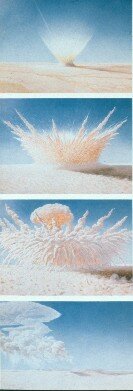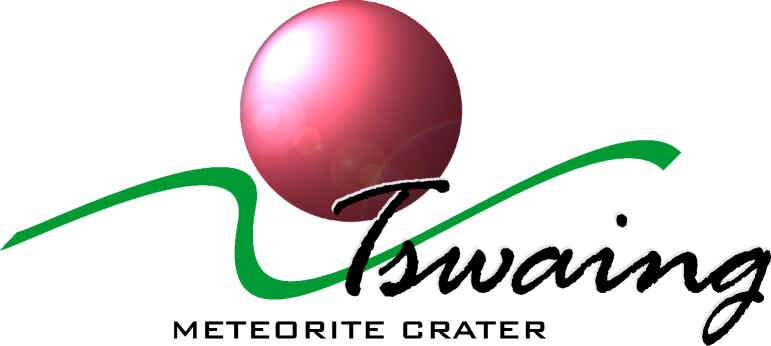|
Artists impression of meteorite impact (courtesy of Barringer Crater Company, Arizona) |
|
|
The Catastrophe |
|
| It is difficult to imagine what the early inhabitants of the Tswaing region would have been confronted with on that particular day, 220 000 years ago. They, most likely, would have observed a sudden enormous brightness high up in the sky, accompanied by a deafening roar. The whole event was extremely short-lived, as the average velocity of 20 to 30 kilometres per second would have taken the meteorite only about ten seconds to travel through the earth's atmosphere, before slamming into the ground. The energy produced can be compared to that of about 1,000 nuclear bombs of the type exploded in 1945 at Hiroshima. In terms of explosive force, the impact explosion would have been a 20-40 megaton TNT event. The size of the crater is a rough indication of the size of the meteorite: a projectile of about 30-50 metres in diameter probably caused a crater with a diameter of 1,13 kilometres, such as Tswaing. The meteorite was probably a chondrite (a type of stony meteorite). The force of the impact and the associated heat caused it to pulverise and vaporise into tiny microscopic fragments. Analyses of some of the platinum-group elements (specifically rhenium and osmium) in breccia and target-rock samples indicated that a small amount (about 0,0015%) of the meteoritic projectile is contained in the melt phase of the breccia layer in the interior of the crater. In the immediate area, around the impact site, all life forms, much of the rock at the surface and below, and the major part of the meteorite would instantaneously have been vaporised. Bedrock from below and around this zone would have been ejected and overturned, forming the crater cavity. Everything that had not been destroyed by the explosive shock wave, in the form of a gigantic air blast, would subsequently have been buried by ejecta and the overturned rocks of the crater rim to a distance of maybe as far as 1,5 kilometres. The air blast, together with the effects of the explosive shock wave, would also have been responsible for regional destruction. Unbelievably strong winds would have formed, reaching wind speeds of more than 1 000 kilometres per hour in an area of at least 3 kilometres surrounding the crater. Closer to the crater, the surface would have been stripped bare of every living or growing organism and all tree growth in a region, possibly as wide as 20 or 30 kilometres, would have been flattened. Further from the crater wind velocity would have declined, but at distances of up to 40 kilometres away surface destruction would still have been significant. Still further away, a large number of trees would have been uprooted. The blast wave would have compressed everything in its path, and for kilometres outwards from the crater every living form would have suffered severely. Another major hazard to any large life forms, such as humans, in the area was all the debris that would have been catapulted outwards from the crater and its immediate vicinity by the air blasts over distances of tens of kilometres. These rough estimates of the damage caused by a relatively small impact event indicate that in an area of at least 1 000 square kilometres (about 35 x 35 km) around the Tswaing Crater near-complete destruction and extinction of all life would have taken place. |
|
|
(Source: REIMOLD, W U, BRANDT, D, DE JONG, R C, HANCOX, J, 1999, Tswaing Meteorite Crater. An introduction to the natural and cultural history of the Tswaing region including a description of the hiking trail. Popular Geoscience Series 1. Pretoria: Council for Geoscience. Available at the Council for Geoscience, Pretoria, South Africa) |
|
|
All intellectual property rights, including but not limited to copyright and trademarks, vested in the material contained on the NFI website is held by the NFI and may not be copied, reproduced, adapted, published or distributed in any form whatsoever without the prior written consent of the responsible person at the NFI. |
|

